|
In addition to today's holiday honoring the life of Dr. Martin Luther King, Jr., January 16th is also National Fig Newton Day (I kid you not), and, according to my handy Librarian's Desk Calendar, Appreciate a Dragon Day. Never heard of it, you say? Well, neither had I, until I did a little Googling, and sure enough, wound up with over 16 million results. Turns out this holiday was created not by a group of obsessed Dungeons and Dragons roleplaying gamers, but by an author, Donita K. Paul in 2004 to herald the release of her children's book, DragonSpell. (Now why didn't I think of that back in September? Maybe I could have created a "Tell Us What's in Your Box Day" to shill for my novel! Too late...) Anyhow, I am happy to lend some appreciation to dragons I have known and loved over years of reading and/or listening... Starting, of course, with Puff... But it was Smaug, the fire-breathing, gold hoarder of J.R.R. Tolkien's The Hobbit, who really captured my imagination as a child... 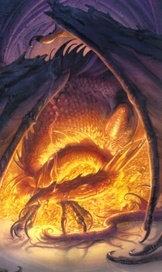 Smaug, terror of The Hobbit Smaug is so covetous and obsessed with his treasure, guarding it, sleeping on it, that pieces of gold and jewels have been embedded in his flesh! Coming to a theatre near you in 2012, courtesy of Peter Jackson and his crew of WETA wizards. But better yet, read the book first! I moved on to other dragons, entering into what I think of as my "classical" phase... First, there was the dragon from the Argonautica, the Greek epic poem by Apollonius Rhodius, which relates the myth of the hero Jason and his band of brothers, the Argonauts, who are given the quest to retrieve the Golden Fleece from the land of Colchis. The fleece, property of the cruel King Aeetes, whose daughter, Medea (yes, that one), is a sorceress, is guarded by, what else, a dragon. 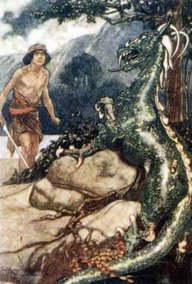 Jason and the dragon (before it falls asleep) Medea's sleeping potion is the key to overcoming this dragon. Jason and Medea hook up, escape the clutches of her father and brother, and the poem ends on a high note. Unfortunately, the marriage doesn't last and all ends badly, very badly. (See Euripides' tragedy, Medea, for the gruesome, dragonless details.) Then I came across the Old English and Norse dragons, the nameless one in Beowulf and the dragon Fafnir (or Fafner) from Wagner's Der Ring des Nibelungen. 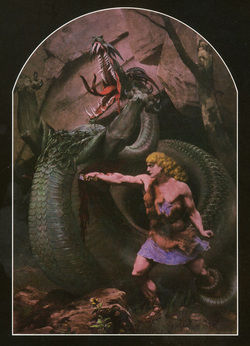 Sigurd slays Fafnir Fafnir is also the villain of William Morse's cod-epic poem The Story of Sigurd the Volsung and the Fall of the Nibelung. Norse hero called Sigurd who forges a mighty sword in order to attack the dragon Fafnir, who guards, what else, a priceless hoard of gold. "He laughed and smote with the laughter and thrust up over his head. / And smote the venom asunder, and clave the heart of Dread". He kills the dragon and gets the gold, but there is, of course, a curse upon it. There are, of course, numerous "neo-modern" dragons, in both children's and adult literature. Ruth Stiles Gannett brought us kid-friendly dragons in her children's books of the 1940s, including My Father's Dragon, in which young Elmer dares a voyage to Wild Island to rescue a baby dragon. 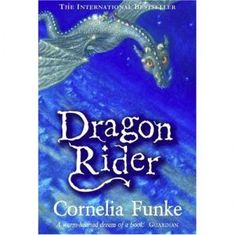 The Harry Potter series featured numerous breeds of dragons, including Hagrid's pet, Norbert. In Dragon Rider, a children's fantasy by Cornelia Funke, the dragons are friendly and approachable, with names like Firedrake and Sorrel. The problem is horrible humans. But the dragons are befriended by a brave orphan, Ben, who becomes the "dragon rider". 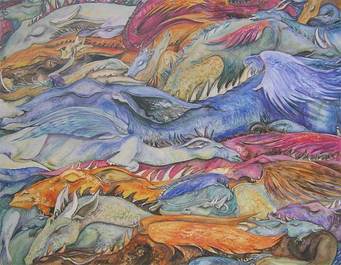 An image for a Terry Pratchett Discworld calendar by Jackie Morris But dragons aren't just for kids. Terry Pratchett has several in his Discworld fantasy series as does George R.R. Martin in Song of Fire and Ice novels. So I suppose dragons do deserve a day of appreciation. They've brought me much wonder and reading pleasure over the years!
1 Comment
|
AuthorTo find out more about me, click on the Not Your Average Jo tab. Archives
February 2024
Categories
All
|
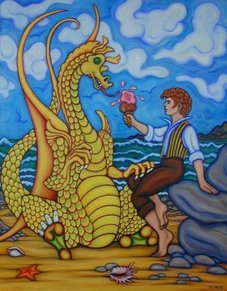
 RSS Feed
RSS Feed